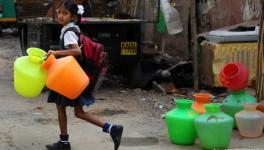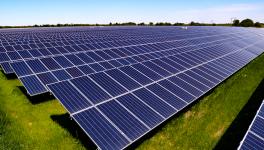It’s Possible to Bring Down Carbon Emissions From Iron & Steel Industry: Report
Representational use only.Image Courtesy: Flickr
Patna/New Delhi: Ahead of the much awaited 27th UN Climate Conference of Parties (CoP27) scheduled to begin in Egypt in November, the Centre for Science and Environment (CSE) in its latest report on Thursday revealed that it is possible to bring down carbon dioxide (CO2) emissions from India iron and steel sector drastically by 2030, while tripling India’s output of steel.
“We can emit even less than what we do today – but all this will need planning, technology and funds,” CSE director Sunita Narain said in a CSE release, while referring to its recent assessment report on the emissions footprints of India’s iron and steel sector and how it can be ‘decarbonised’.
Narain said the CSE roadmap to bring down carbon emissions from India’s iron and steel industry “focusses on strategies for both manufacturing routes”.
“Countries like India need to grow and develop, and this at a time when the world is running out of carbon budget to stay below the guardrail of 1.5°C temperature rise. Hence, this growth has to be low in carbon. It must be as green as it can be. How do we ensure the double benefits of reduced emissions and growth? Our new report shows us the way.”she said.
The iron and steel sector is a hard-to-abate sector in terms of greenhouse gas (GHG) emissions. At the same time, it is a critical contributor to the economic development of the country. Globally, the sector accounts for some 7% of total greenhouse gas emissions; in India, the sector’s share is 5% (as per the latest inventory available for 2016), as per the report.
In the iron and steel sector, the manufacturing process determines the amount of CO2 an industrial unit will produce. Coal is key to the production of iron in a blast furnace, and for making steel through a basic oxygen furnace (BF-BOF). “This makes the sector hard to decarbonise -- roughly half of India’s iron and steel is produced through this route,” as per the CSE research.
The bottom line,” said Narain, “is that it is possible to bend the CO2 curve even for a sector like iron and steel. Countries like India can develop while drastically reducing their GHG emissions. The only question is if the rich world will accept the imperative of climate justice and provide the funds for the technology transformation necessary for a future-ready industry. This is what CoP27 should discuss.”
The other way to manufacture iron is the direct reduced iron (DRI) or sponge iron method. In this, iron is extracted using reducing agents like coal or gas, and steel is produced thereafter through an electric-arc or induction furnace. Parth Kumar, programme manager, Industrial Pollution Unit, CSE, said in his comments in the report that “this production process is easier to decarbonise as coal can be replaced by natural gas; also, steel scrap can replace iron ore completely.”
In India, iron and steel manufactured using DRI is far more polluting because it is coal-based. Since sponge iron plants operate largely in the small and medium sectors, there is no impetus to improve their emissions profile.
“This is where the opportunity lies; the government should work on a package that involves a cleaner fuel like gas and improves the circularity of the recycled steel business by promoting optimum usage of steel scrap as a raw material”, the CSE report said.
According to the report, in a business-as-usual scenario, GHG emissions from the sector are estimated to grow 2.5 times (up to 659 million tonne or MT) by 2030 compared with 2020-21 (271 MT). CSE’s recommendations can reduce these emissions by 64 to 79 per cent(419 to 519 MT) by 2030, even after tripling the production
CSE has recommended a fuel change – in the case of BF-BOF, the use of natural-gas injection or hydrogen to reduce the use of coal is recommended, along with increasing the amount of recycled steel in production to its optimum of 30%.
The industry should implement carbon capture and utilisation to bring down coal-based emissions.
The switch to new fuels and technologies will require international finance. The government and steel industry should work towards a combined proposal for climate finance with touch targets for 2030 -- from 2.2 tonne of CO2 for every tonne of iron and steel to less than 1.5 tonne.
Three established companies – Tata Steel, SAIL and JSW – which accounted for 45% of the country’s steel production in 2020-21, contributed almost 42% of the GHG emissions from the sector. Narain pointed out that this offers an “opportunity for financial infusion” for making low-carbon steel – envisaging a significant role for international climate finance.
The CSE research shows that the coal-based DRI-EAF/IF technology (mostly in use in the small- and medium-scale sectors) is contributing almost 51% of the total GHG emissions from the sector in India as of 2020-21.
Nivit Kumar Yadav, programme director, Industrial Pollution Unit, CSE, said in the report that: “The big opportunity is to re-work the DRI-EAF route. This would require working with the medium and small scale units so that they are enabled to either make the switch to a cleaner fuel (natural gas) or move towards 100 per cent use of scrap material for steel production. This requires a steel mission for sponge-iron plants so that they are provided the assistance to make this transition.”
Get the latest reports & analysis with people's perspective on Protests, movements & deep analytical videos, discussions of the current affairs in your Telegram app. Subscribe to NewsClick's Telegram channel & get Real-Time updates on stories, as they get published on our website.
























